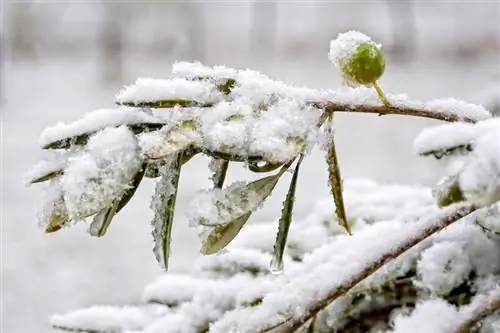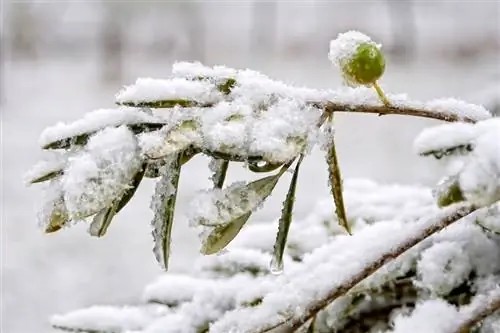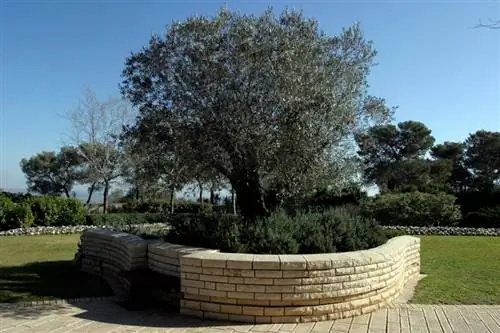- Author admin [email protected].
- Public 2023-12-16 16:46.
- Last modified 2025-01-23 11:19.
The popular olive trees come from a fairly warm but dry climate with long summers and short, mild winters. As a result, the Mediterranean plant is not necessarily made for the typical German winter. Slightly frosty temperatures of down to minus 10 °C are generally well tolerated for a short period of time, but this depends on how the tree is grown and the age of the tree.

Can olive trees tolerate frost?
Olive trees are not frost hardy and can only tolerate light frost temperatures down to -10 °C for a short time. In winter they should be kept cool and bright at 8-10 °C, protected from deep frost and with frost-free soil and a well-insulated pot and trunk.
Olives are not frost hardy
Many online shops and forums like to claim that olives are generally frost hardy. Some varieties can even tolerate temperatures as low as minus 19 °C without being damaged. You shouldn't believe these statements because olives are not made for the cold German winter. In the cold season they feel most comfortable at temperatures of around 8 to 10 °C, although they can also tolerate light frosts well down to just below freezing point - but only if the frost is limited to a short period of time. Some varieties can even tolerate frosts down to minus 10 °C. Longer periods of frost and low temperatures, on the other hand, damage the tree so much that in extreme cases it can freeze to death.
Getting olives used to the frost
However, you can get your olives used to the frost so that older trees in particular could overwinter outdoors without major problems. This point is not important for young trees, as they can simply be moved to another winter-proof location - trees that are several decades or even centuries old are usually no longer so easy to move. Basically, young trees are much more sensitive than older ones. In order for them to lose their sensitivity, a gentle habituation is necessary. However, this doesn't mean that you simply expose your young tree to low temperatures - instead, simply leave it outside for a little longer each year and watch it carefully to see how it tolerates the temperatures.
Wintering the olive tree properly
However, you should definitely not forget the right frost protection. Since most olives in Germany are kept in containers, the most important thing is to prevent the substrate from freezing. Place your potted olive in a bright, cool location. This can be a cool stairwell, but also a sheltered corner on the balcony or terrace. The olive is best placed directly on the wall of the house, although you should not place the pot directly on the ground. A thick surface, e.g. B. made of Styrofoam or wood, protects against ground frost. Also cover the soil thickly with bark mulch or brushwood. If there is deep frost or permanent frost, you should install root heating (€38.00 on Amazon) and also wrap the trunk and crown well with mats made of straw, coconut or jute.
What you should pay attention to when wintering
- Always have the current weather report ready so that you can react quickly in an emergency
- don't keep your olive too warm because it needs to rest for the winter
- Olives are often attacked by pests when kept too warm
- light frost kills pests
- don't forget to water your olive from time to time
- Rule of thumb: The cooler the temperature, the less you need to water
Tips & Tricks
Even in winter, your olive tree needs a lot of sun. If the tree drops its leaves, this is usually an indication of a lack of light.






